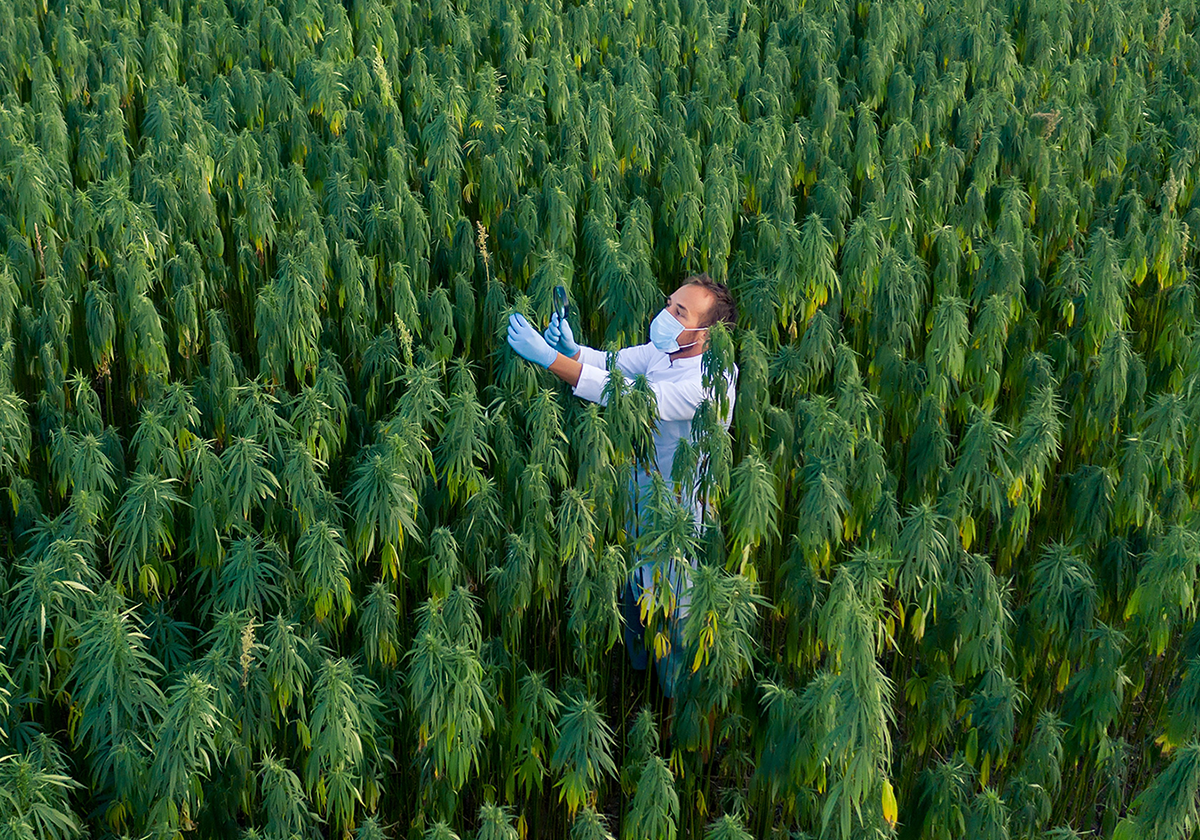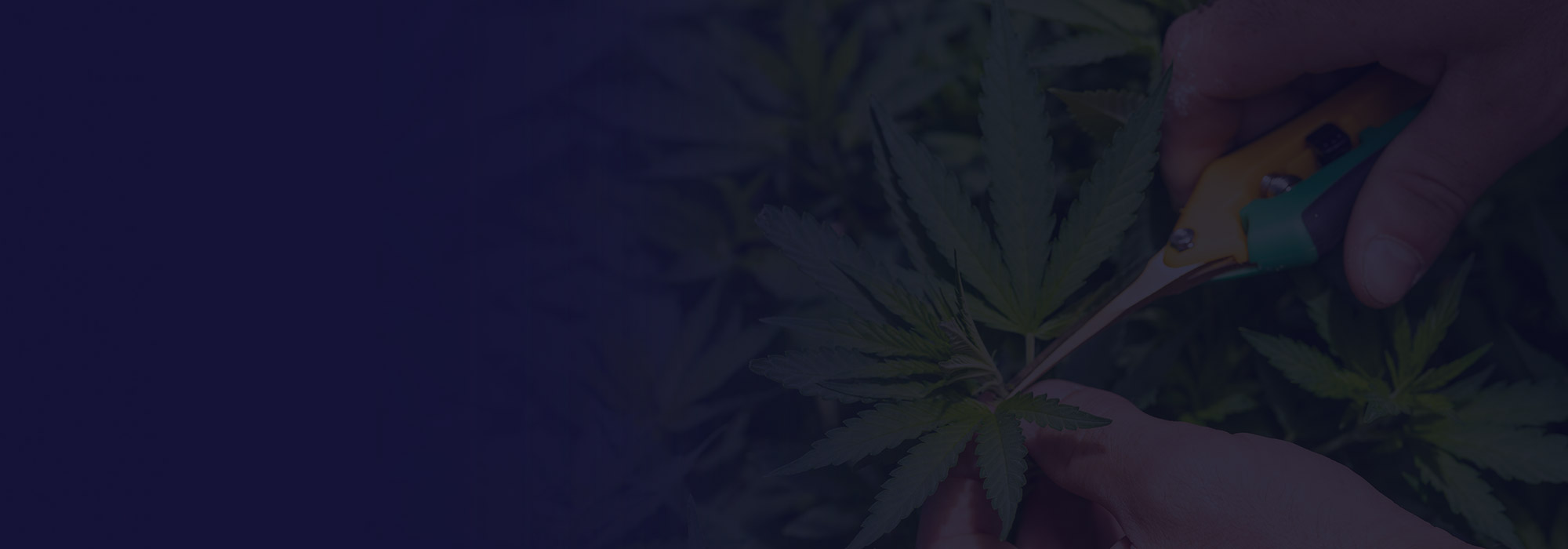Even though it is often overshadowed by marijuana’s reputation, hemp deserves attention too. Let’s explore the history, uses and associated risks surrounding this oft-forgotten crop.
A versatile staple
Marijuana and hemp are, believe it or not, the same plant. The distinction between the two lies in the levels of THC. Unlike marijuana, a plant grown for its psychoactive potency, hemp contains much lower levels of THC and is grown and harvested primarily for its fiber and seeds. In addition, hemp can be grown in most climates and requires little care during cultivation; marijuana, on the other hand, must be grown in carefully monitored spaces.
Regardless of the notable distinctions between hemp and marijuana, the production of hemp was outlawed in 1937 when cannabis was made illegal by the United States federal government under the Marihuana Tax Act. It was further regulated in 1970 when the crop was added to the Controlled Substances Act. Many argued that grouping hemp with marijuana was short-sighted: one was a narcotic while the other was an extremely useful crop with numerous uses. Thanks to political pressure, the 2018 Farm Bill legalized industrial hemp (classified as hemp with less than 0.3% THC by dry weight) production on a federal level.
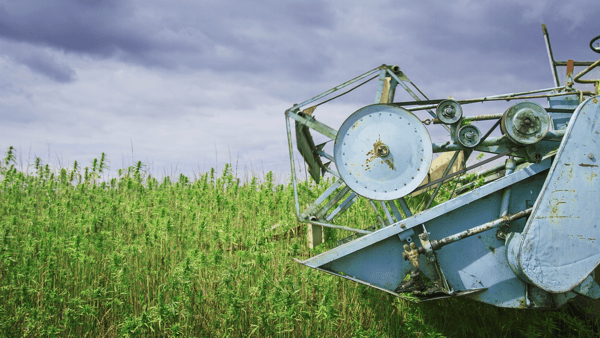 Due to its versatility, hemp was one of the first plants to be cultivated by humans.
Due to its versatility, hemp was one of the first plants to be cultivated by humans.
Related:
A Faster, Easier Way to Manage Cannabis Risk
The legalization of hemp has paved the way for a new and growing commercial sector in the United States. The market for industrial hemp is expected to grow from $4.6 billion in 2019 to $26.6 billion by 2025.4 Hemp's versatility has made it a mainstay of agriculture, utilized for its far-ranging benefits across numerous industries:
- Building materials: Lightweight, mold-resistant, and sustainable, hemp is used in the production of insulation, concrete (known as “hempcrete”), wood, rope, plaster, varnishes, and paints.
- Textiles: Hemp fiber can be used to create fabrics, notably sail canvas. Clothing, shoes, and accessories can all be made from hemp textiles.
- Paper: Pulp from hemp offers longer fibers and increased tear resistance compared with normal wood pulp. Hemp is often used to produce specialty papers like banknotes and coffee filters.
- Composite materials: Hemp fibers are utilized to build composite panels for automobiles. Currently, car manufacturers such as BMW, Mercedes, Volkswagen, and Ford utilize hemp in one way or another.
- Biofuels: Oil in hemp seeds and stalks can be turned into biodiesel, and hemp fermentation can produce alcohol fuel.
- Plastics: In contrast with PVC plastics, hemp-based plastic is biodegradable.
- Food: Hemp seeds are an incredibly nutritious source of protein, fiber, omega-3 fatty acids, and several vitamins and minerals.5
- Cosmetics: Hemp seed oil is high in fatty acids, making it an effective moisturizer in products such as creams, balms, soaps, and shampoos.
- CBD Products: Cannabidiol, a non-psychoactive cannabinoid found in both hemp and cannabis, is used in various consumer products, including oils, sprays, topical cosmetics, candies, and other consumables.
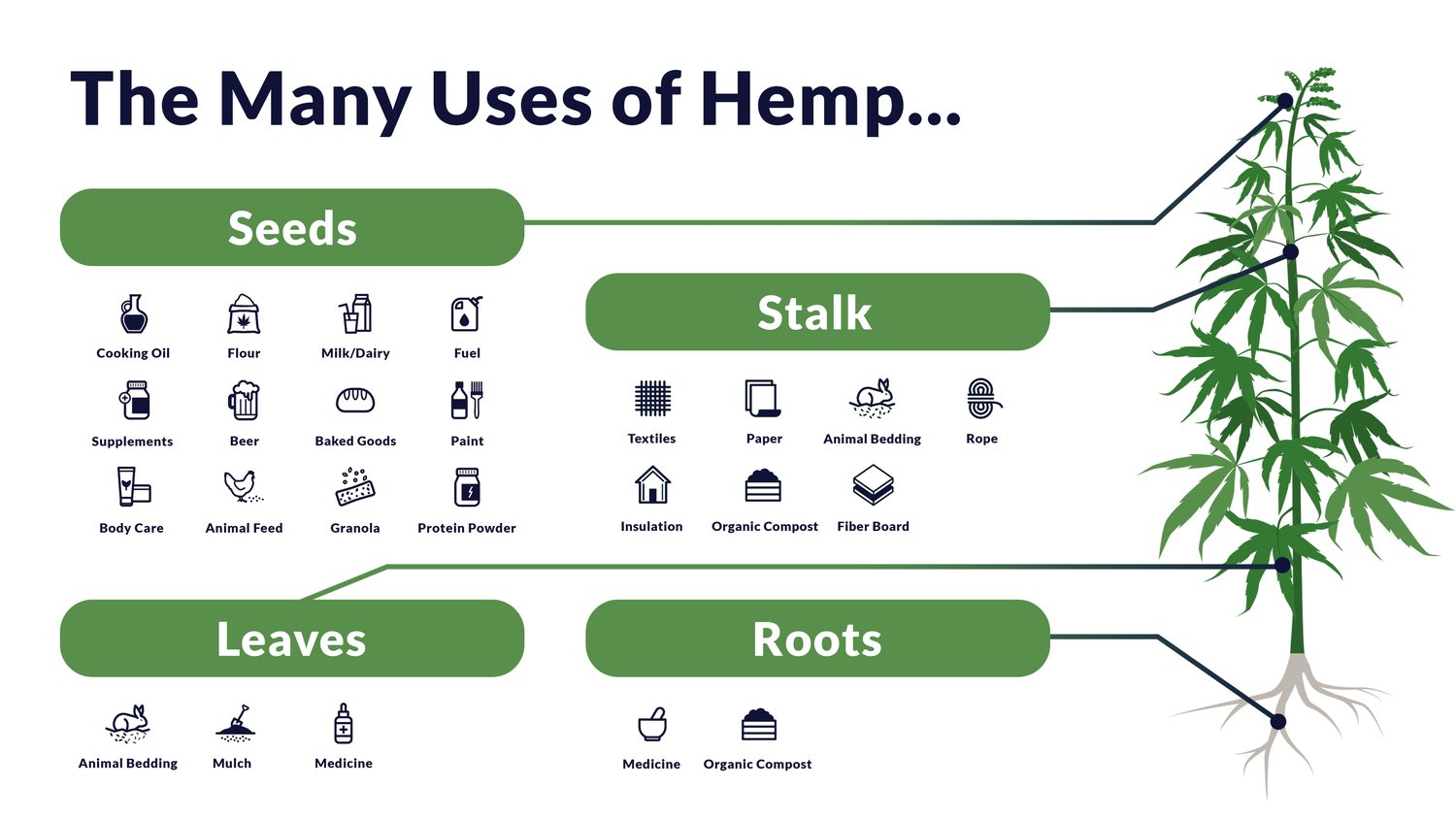
Types of hemp
Various hemp varieties exist, and each strain embodies different characteristics that make them suited to different applications.6 The three main types are fiber hemp, grain hemp, and CBD-rich hemp.
Fiber hemp:
This variety is characterized by long fibers and biomass. Fiber hemp is used to produce building materials, textiles, paper, composite materials, fuel, and more. Industrial cultivation of this variety requires infrastructure able to handle large-scale growing, harvesting, and processing.
Grain hemp:
This variety emphasizes seed production and, due to high protein, fatty acid, and fiber content, is primarily utilized in food and nutritional applications. Unlike the robust nature of fiber hemp, grain hemp is characterized by thin-walled, delicate seeds that require more care throughout the procedures of harvesting, transporting and processing. Additionally, due to their consumable nature, hemp seeds require attentive monitoring to prevent potential spoilage.
CBD-rich hemp:
This variety is undoubtedly the most lucrative of the three primary hemp varieties. Cannabinol, or CBD, is a molecule within hemp with numerous applications as a nutraceutical, pharmaceutical, or dietary supplement. Production of CBD products requires a much more hands-on approach to cultivation. To produce high-quality, high-yield CBD-rich hemp, farmers must stay attentive to soil composition, moisture content, PH levels, and other variables that contribute to an exceptional final product. Confused? We’ll take an in-depth look at CBD in the next section.
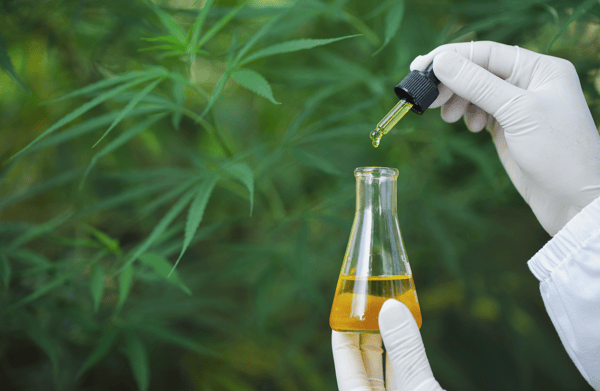 In recent years, hemp-derived CBD has become extremely popular.
In recent years, hemp-derived CBD has become extremely popular.
Related:
New Data to Manage Emerging Risks: You Now Have Access
The ABCs of CBD
Let’s start off with the basics: what exactly is CBD?
The cannabis plant contains a wide variety of compounds, and chief among them is THC, or tetrahydrocannabinol. THC is the primary psychoactive cannabinoid in marijuana - in other words, it’s the stuff that gets you high. In addition to THC, cannabis contains 483 other known compounds, over 100 of which are cannabinoids. CBD, or cannabidiol, is one of the more prominent of these additional cannabinoids.
So, what’s so special about CBD anyway?
Long story short, the jury is still out. CBD has been advertised as providing relief from anxiety, depression, PTSD, and insomnia – however, clinical research studies have yet to corroborate such assumptions.7, 8
Whether it’s an effective treatment for various ailments or just a placebo, CBD is massively popular nowadays. In fact, conservative projections put the CBD industry on track to hit $16 billion by 2025. The upswing in popularity, in conjunction with federally legal hemp, means we are likely to see more and more CBD-rich hemp production moving forward.
The risks that lie ahead
Though hemp production may not be as fraught with risk as marijuana, it does not mean you can ignore it. Staying aware of the dangers associated with hemp production is key to mitigating potential risk.9
Harvesting:
Hemp plants have thick stalks that can be tough on conventional, non-hemp harvesting equipment. Damage to equipment can lead to expensive repairs down the line.
Drying techniques:
Once hemp is harvested, it must dry out the plant material before processing. There are two primary ways hemp can be dried: hang dry and using drying machines.
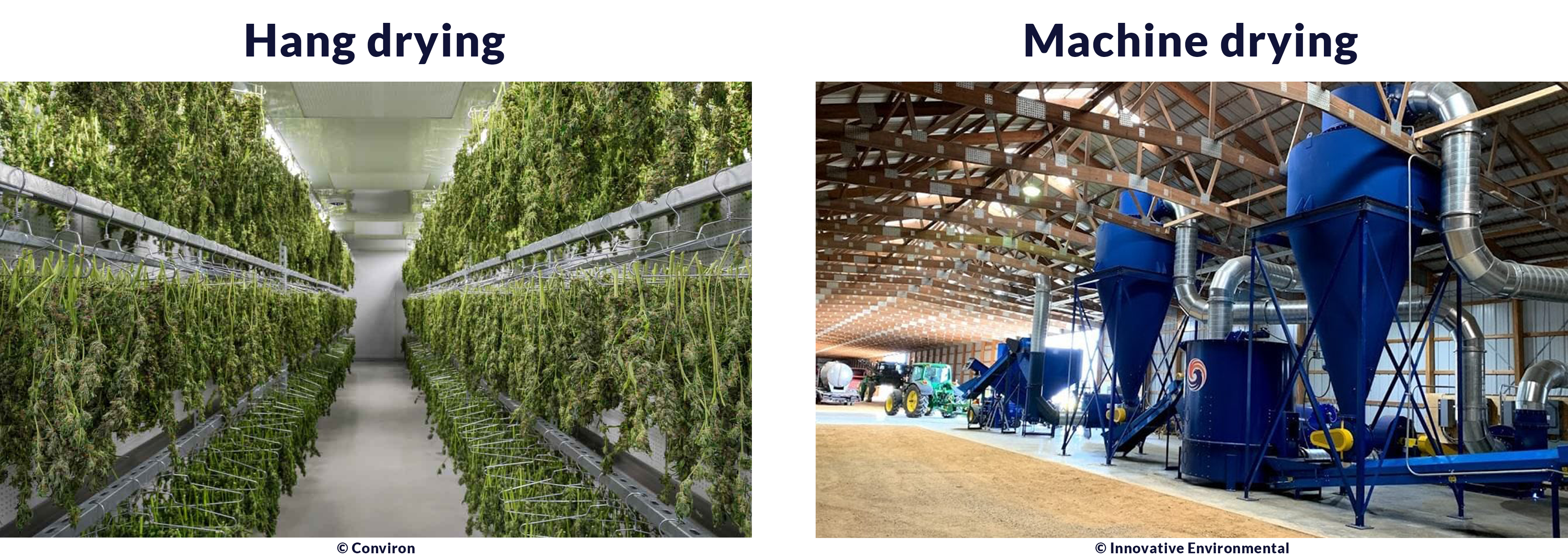
Hang drying plants is a slow process, best suited for smaller growing operations. Overall, this process does not have too many major risk factors associated with it.
Drying hemp with machines is a much more efficient process requiring specialized machines using natural gas or propane to heat and circulate the air. Without proper maintenance and preventative measures, drying machines are prone to fire and explosion.
Oil production:
Synthesizing CBD oil brings about its own types of risks.10 While curated “boutique” CBD brands employ relatively safe extraction processes using carbon dioxide (CO2), large-scale extraction operations use ethanol and liquid solvents. Compared to utilizing CO2, ethanol and solvent extraction are much more time-efficient methods for producing CBD oil. However, ethanol and liquid solvents are highly flammable, upping the risk of fire.
Legality and compliance:
Under the 2018 Farm Bill, hemp is defined as cannabis with 0.3% THC or less – anything above this number is illegal under federal law. For this reason, farmers must keep the THC level within legal limits. If they fail to do so, they are required by law to burn all crops that have exceeded the 0.3% limit. To avoid legal troubles down the line, farmers need to have proper education regarding methods for growing, harvesting, and processing hemp.
Another legal concern surrounds delta-8, a cannabinoid found in cannabis plants, including hemp.11 Unlike CBD’s non-psychoactive characteristics, delta-8 produces a “high” more akin to THC found in marijuana. A legal grey area currently exists wherein delta-8 is not regulated by the federal government, and there’s no mention of it in the 2018 Farm Bill. If hemp is moved back to a Schedule 1 status due to delta-8, this would cause a massive disruption to current industrial hemp growing operations.
Product liability:
Businesses engaged in the manufacturing and/or sale of hemp-derived CBD products need to be aware of potential customer lawsuits and other liability issues. Due to the unconfirmed nature of CBD, making claims about medical benefits is dangerous and may bring legal ramifications. Whether due to improperly marked packaging or lack of quality control, customers can sue businesses for damages they suffer from using their products.
There are additional liability considerations surrounding delta-8. Some hemp manufacturers have begun creating concentrated delta-8 products, things like gummies and candy, that skirt around the rules surrounding intoxicating cannabis products. The CDC and FDA have both pointed towards delta-8 as possessing a notable amount of adverse side effects. Without regulation, these products are currently sold without warning labels, creating a perfect storm for future liability claims.
Theft
Much like marijuana, CBD products are high-value items. Facilities where CBD is stored are susceptible to theft and associated property damage.
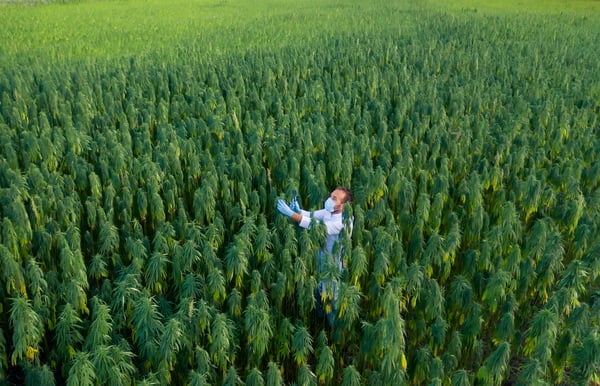 Industrial hemp creates a variety of risks for property insurers,
Industrial hemp creates a variety of risks for property insurers,
risks that are time-consuming to stay on top of.
Related:
Get the Information You Need to Make Better Decisions About Risk
Mitigating exposure
Hemp can affect risks related to multiple coverage lines, so knowing your concentration of risk is especially important.
HempGuard makes it easy to understand how much hemp-related risk you’re carrying and use that information to make better underwriting decisions. You’ll see whether a property you insure or are considering insuring is involved in or in proximity to hemp-related operations. Visualizing risk concentration in a clear, understandable format gives you the ability to manage it in an effective and timely manner.
Don’t let hemp risk spread unknown in your book. Try BuildingMetrix® HempGuard today. Contact us to learn more.
[1] Healthline, https://www.healthline.com/health/hemp-vs-marijuana
[2] govinfo, https://www.govinfo.gov/content/pkg/STATUTE-84/pdf/STATUTE-84-Pg1236.pdf
[3] USDA, https://www.usda.gov/farmbill
[4] Markets and Markets, https://www.marketsandmarkets.com/Market-Reports/industrial-hemp-market-84188417.html
[5] NCBI, https://www.ncbi.nlm.nih.gov/pmc/articles/PMC2868018/
[6] Root Origins, https://www.rootorigins.com/the-different-types-of-hemp-fiber-grain-and-cbd-rich/
[7] New York Times, https://www.nytimes.com/2019/10/16/style/self-care/cbd-oil-benefits.html
[8] NCBI, https://www.ncbi.nlm.nih.gov/pmc/articles/PMC6949116/
[10] Thomas, https://www.thomasnet.com/articles/other/cbd-manufacturing-how-cbd-oil-is-made/
[11] WebMD, https://www.webmd.com/mental-health/addiction/news/20220131/delta-8-thc-what-to-know


